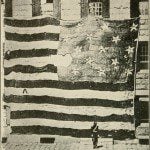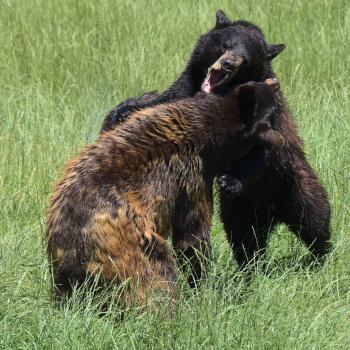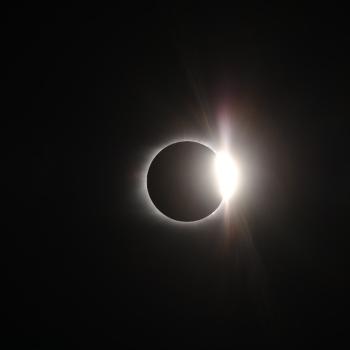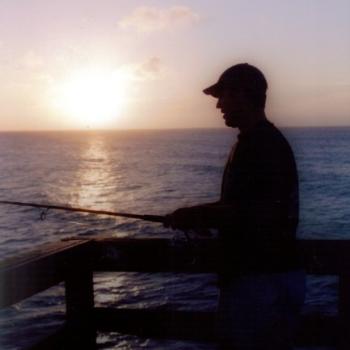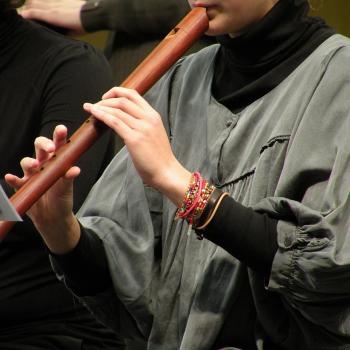
I grew up on Star Trek reruns, syndicated on the local UHF channels in the evenings. Heck, my parents have a big painting of Kirk and Spock on their wall. (A reproduction of the cover of the first issue of Starlog.) My high school physics teacher nicknamed me “Spock”, and as kids my brother and I had Starfleet uniform shirts, mine science blue, his command yellow.
The Pagan movement as we know it blossomed in the 1960s, and science fiction played a significant role. Heck, the Church of All Worlds took its name and some of its structure from a Robert Heinlein novel. As Margot Adler wrote in Drawing Down The Moon,
[S]cience fiction and fantasy probably come closer than any other literature to systematically exploring the central concerns of Neo-Pagans and Witches. Such writers of science fiction and fantasy are bound less than any others by the political, sexual, and racial mores of their society….Science fiction has been the literature of the visionary; it has been able to challenge preconceived notions about almost everything, while at the same time attending to fundamental questions of the age. No wonder, then, that not only do so many Pagans and Witches read science fiction, but some of them write it. In my travels I came across four well-known science fiction and fantasy writers who were members of Neo-Pagan groups. Of the four, only one — Robert Anton Wilson — was public. The remaining three did not wish to have their identities disclosed. [p 285, 1986 edition]
Star Trek was part of the zeitgeist — probably the most accessible science fiction — and had an interesting influence on Paganism’s development. Indeed, according to the wik Gene Roddenberry once referred to himself as a “complete pagan” — though in context is seems he was denying any religiosity rather than claiming Neo-Paganism. Still, he did marry Majel Barrett in a Shinto ceremony, demonstrating some affinity for an ancient Pagan religion. It strikes me that he may have been interested in “humanistic Paganism” or “atheo-Paganism” if these ideas had been brought to his attention, though I’m just speculating.
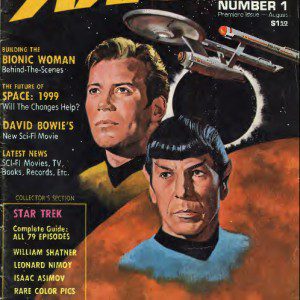
Still, Trek did give viewers the elfin-eared Vulcan Mr. Spock, who projected a logical detachment from destructive emotions while also jamming out with space hippies and engaging in mystical, hypnotic, telepathic “mind melds” that questioned the nature of the self. He was a sort of Space Age Merlin to Kirk’s King Arthur. Without him, would Paganism be so heavy with engineers, programmers, and scientists?
Star Trek’s attitude toward religion was not one where gods fared well. In the (second) pilot episode “Where No Man Has Gone Before,” after an encounter with a mysterious energy field a crew member starts to develop god-like powers, and Captain Kirk has to kill him. In a later episode, “Who Mourns for Adonais?”, Kirk and the crew actually knock off Apollo, who turns out to be an alien being who visited Earth thousands of years ago. Several cultures have computers that the locals think of as being gods – Kirk short-circuits them or blows them up.
Even though military hierarchy is strictly maintained on the ship, Star Trek radically overthrew the cosmic hierarchy of the Judeo-Christian tradition, and gave us something more in the Greco-Roman style: men (and women and Vulcans) who can strive with gods.
So: happy 50th Anniversary. Keep on Trekkin’.
You can keep up with “The Zen Pagan” by subscribing via RSS or e-mail.
What Does It Mean For The Gods To Exist? and other essays is now available as a free e-book! It collects my run on the Patheos Agora blog plus a few bonus pieces.
If you do Facebook, you might choose to join a group on “Zen Paganism” I’ve set up there. And don’t forget to “like” Patheos Pagan and/or The Zen Pagan over there, too.


